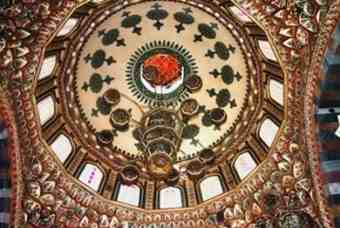Al-Azem Palace in the central Province of Hama is one of the most important archaeological monuments in Syria dating back to 1740 AD.
 The architectural style of the Palace is an excellent example of Damascene traditional houses as it consists of two main wings: the Haramlik and the Salamlik.
The architectural style of the Palace is an excellent example of Damascene traditional houses as it consists of two main wings: the Haramlik and the Salamlik.
The family wings or Haramlik is a special space connected to the kitchen and servant quarters. It includes baths, which are a replica of the public baths but on a smaller scale. The public area reserved for guests, called the Salamlik, contains the formal halls, reception areas and exclusive courtyards for entertainment.
Director of Hama Antiquities Department Abdul-Qader Ferzat said that the two rooms at the upper floor of the building which date back to 1782 and 1783 AD are distinguished by their decoration, arabesques and drawings which were made of silver with a very high quality.
Ferzat indicated that the Hall No. 60 at Salamlik wing was considered one of the most wonderful rooms in the East and the West during the 18th century where the embellishments are similar to those carved on leather in France in addition to using an ancient design depending on ceramic that was very commonly used in Deutschland in the 17th century.
He indicated that the design of room No. 60 resembles the Ottoman brocade which is a unique example of drawing and painting techniques.
 The room No. 61 is distinguished by the protruding drawings which were made of plaster where one can see 80 drawings representing fishes at the roof daubed with a layer of silver and surrounded by wonderful flowers made with high preciseness.
The room No. 61 is distinguished by the protruding drawings which were made of plaster where one can see 80 drawings representing fishes at the roof daubed with a layer of silver and surrounded by wonderful flowers made with high preciseness.
The room also includes several mirrors with wooden frames painted with silver and gilded at their sides in addition to a number of protruding wooden artifacts ending with magnificent roses.
The Palace has also two courtyards one on each floor. The courtyard on the ground floor is decorated with trees to provide shade, and has a fountain in the middle working as a cooling and refreshing system.
At one end of the building there is a liwan 'large sitting room' with 3 sides where the residents used to sit. The second floor courtyard was purposely built to make use of breezes and the cool air.
The Palace has been used as a museum since 1965, displaying archaeological finds from various sites in and around Hama, including the Citadel.
Author: Ruaa al-Jazaeri | Source: Global Arab Network [August 10, 2010]